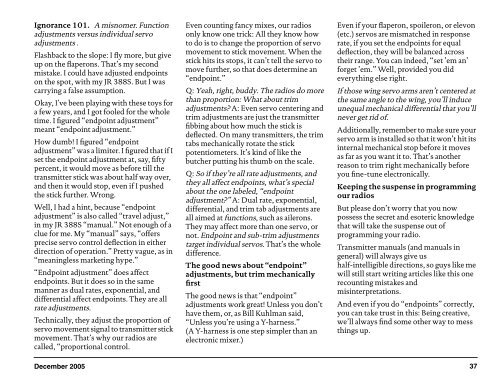December 2005 — Vol. 22, No. 12 - RC Soaring - RCSoaring.com
December 2005 — Vol. 22, No. 12 - RC Soaring - RCSoaring.com
December 2005 — Vol. 22, No. 12 - RC Soaring - RCSoaring.com
You also want an ePaper? Increase the reach of your titles
YUMPU automatically turns print PDFs into web optimized ePapers that Google loves.
Ignorance 101. A misnomer. Function<br />
adjustments versus individual servo<br />
adjustments .<br />
Flashback to the slope: I fly more, but give<br />
up on the flaperons. That’s my second<br />
mistake. I could have adjusted endpoints<br />
on the spot, with my JR 388S. But I was<br />
carrying a false assumption.<br />
Okay, I've been playing with these toys for<br />
a few years, and I got fooled for the whole<br />
time. I figured “endpoint adjustment”<br />
meant “endpoint adjustment.”<br />
How dumb! I figured “endpoint<br />
adjustment” was a limiter. I figured that if I<br />
set the endpoint adjustment at, say, fifty<br />
percent, it would move as before till the<br />
transmitter stick was about half way over,<br />
and then it would stop, even if I pushed<br />
the stick further. Wrong.<br />
Well, I had a hint, because “endpoint<br />
adjustment” is also called “travel adjust,”<br />
in my JR 388S “manual.” <strong>No</strong>t enough of a<br />
clue for me. My “manual” says, “offers<br />
precise servo control deflection in either<br />
direction of operation.” Pretty vague, as in<br />
“meaningless marketing hype.”<br />
“Endpoint adjustment” does affect<br />
endpoints. But it does so in the same<br />
manner as dual rates, exponential, and<br />
differential affect endpoints. They are all<br />
rate adjustments.<br />
Technically, they adjust the proportion of<br />
servo movement signal to transmitter stick<br />
movement. That’s why our radios are<br />
called, “proportional control.<br />
Even counting fancy mixes, our radios<br />
only know one trick: All they know how<br />
to do is to change the proportion of servo<br />
movement to stick movement. When the<br />
stick hits its stops, it can’t tell the servo to<br />
move further, so that does determine an<br />
“endpoint.”<br />
Q: Yeah, right, buddy. The radios do more<br />
than proportion: What about trim<br />
adjustments? A: Even servo centering and<br />
trim adjustments are just the transmitter<br />
fibbing about how much the stick is<br />
deflected. On many transmitters, the trim<br />
tabs mechanically rotate the stick<br />
potentiometers. It’s kind of like the<br />
butcher putting his thumb on the scale.<br />
Q: So if they’re all rate adjustments, and<br />
they all affect endpoints, what’s special<br />
about the one labeled, “endpoint<br />
adjustment?” A: Dual rate, exponential,<br />
differential, and trim tab adjustments are<br />
all aimed at functions, such as ailerons.<br />
They may affect more than one servo, or<br />
not. Endpoint and sub-trim adjustments<br />
target individual servos. That’s the whole<br />
difference.<br />
The good news about “endpoint”<br />
adjustments, but trim mechanically<br />
first<br />
The good news is that “endpoint”<br />
adjustments work great! Unless you don’t<br />
have them, or, as Bill Kuhlman said,<br />
“Unless you’re using a Y-harness.”<br />
(A Y-harness is one step simpler than an<br />
electronic mixer.)<br />
Even if your flaperon, spoileron, or elevon<br />
(etc.) servos are mismatched in response<br />
rate, if you set the endpoints for equal<br />
deflection, they will be balanced across<br />
their range. You can indeed, “set ’em an’<br />
forget ’em.” Well, provided you did<br />
everything else right.<br />
If those wing servo arms aren’t centered at<br />
the same angle to the wing, you’ll induce<br />
unequal mechanical differential that you’ll<br />
never get rid of.<br />
Additionally, remember to make sure your<br />
servo arm is installed so that it won’t hit its<br />
internal mechanical stop before it moves<br />
as far as you want it to. That’s another<br />
reason to trim right mechanically before<br />
you fine-tune electronically.<br />
Keeping the suspense in programming<br />
our radios<br />
But please don’t worry that you now<br />
possess the secret and esoteric knowledge<br />
that will take the suspense out of<br />
programming your radio.<br />
Transmitter manuals (and manuals in<br />
general) will always give us<br />
half-intelligible directions, so guys like me<br />
will still start writing articles like this one<br />
recounting mistakes and<br />
misinterpretations.<br />
And even if you do “endpoints” correctly,<br />
you can take trust in this: Being creative,<br />
we’ll always find some other way to mess<br />
things up.<br />
<strong>December</strong> <strong>2005</strong> 37
















